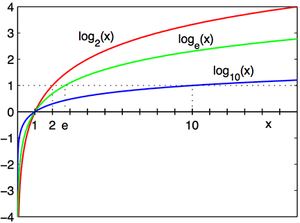Logarithm (nonfiction): Difference between revisions
Jump to navigation
Jump to search
No edit summary |
No edit summary |
||
| Line 14: | Line 14: | ||
== Fiction cross-reference == | == Fiction cross-reference == | ||
* [[Crimes against mathematical constants]] | |||
* [[Gnomon algorithm]] | * [[Gnomon algorithm]] | ||
* [[Mathematics]] | |||
== Nonfiction cross-reference == | == Nonfiction cross-reference == | ||
| Line 20: | Line 22: | ||
* [[Decade (log scale) (nonfiction)]] | * [[Decade (log scale) (nonfiction)]] | ||
* [[Exponentiation (nonfiction)]] | * [[Exponentiation (nonfiction)]] | ||
* [[Prosthaphaeresis (nonfiction)]] | |||
* [[Super-logarithm (nonfiction)]] | * [[Super-logarithm (nonfiction)]] | ||
* [[Mathematics (nonfiction)]] | * [[Mathematics (nonfiction)]] | ||
Latest revision as of 17:33, 13 February 2018
In mathematics, the logarithm is the inverse operation to exponentiation, just as division is the inverse of multiplication and vice versa.
The logarithm of a number is the exponent to which another fixed number, the base, must be raised to produce that number.
In simple cases the logarithm counts factors in multiplication. For example, the base 10 logarithm of 1000 is 3, as 10 to the power 3 is 1000 (1000 = 10 × 10 × 10 = 103); 10 is used as a factor three times.
More generally, exponentiation allows any positive real number to be raised to any real power, always producing a positive result, so the logarithm can be calculated for any two positive real numbers b and x where b is not equal to 1.
In the News
Fiction cross-reference
Nonfiction cross-reference
- Decade (log scale) (nonfiction)
- Exponentiation (nonfiction)
- Prosthaphaeresis (nonfiction)
- Super-logarithm (nonfiction)
- Mathematics (nonfiction)
External links:
- Logarithm @ Wikipedia
